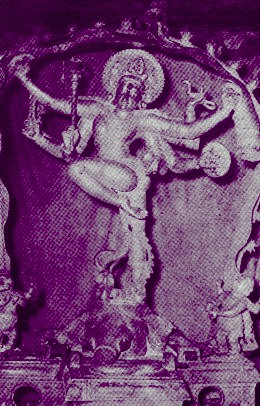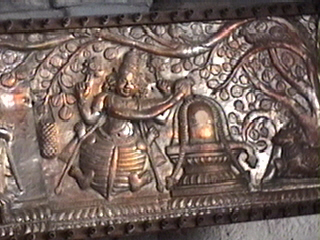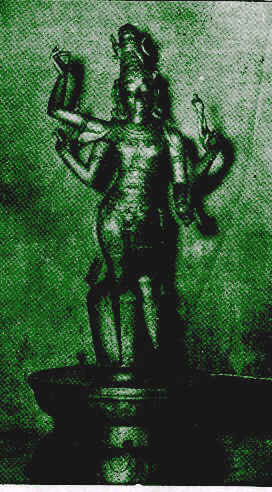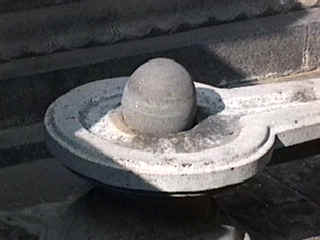This legend relates to the slaying of the demon Gajaasuran by Shiva. There are eight such legends portraying Shiva as the destroyer of evil.
Gajaasuran, a demon who had the form of an elephant (gaja) tormented the universe and terrified the gods and the humans. Continuing unchecked, he proceded to attack Shiva's abode. A terrified Parvati beseeched Shiva to put an end to the attrocity, and Shiva obliged by flaying the skin of the demon and wearing it as a drape around him - and then danced the dance of victory.
A splendid bronze image of Gajasamhaaramurthy is held in worship at Vazhuvoor near Mayiladuturai in Tamilnadu. Vazhuvoor is one of the 8 Veeratta temples celebrating Shiva as the destroyer of evil forces.
Shiv Aradhna
Saturday, March 26, 2011
Gajaasura Samhaaram - Slaying of the demon Gajaasuran
The Story of Amrita - the Celestial Nectar
This legend is of great importance both in Saivite and Vaishnavite system of beliefs. The devas and the asuras (gods and demons) united in their efforts to churn the celestial ocean of milk (ksheerasaagaram), in quest of Amrita (the nectar of life and immortality). This mammoth task was carried out with the Mandara Mount as the churning stick and the mythological snake Vasuki as the rope.
Vishnu assumed the Koorma avatara (tortoise) to hold the Mandara mountain in place and to prevent it from sinking into the ocean. Lakshmi the Goddess of wealth emerged from the ocean, and so did the moon god Chandra. Then came the dreaded poision, Kaalakoota. The gods and demons appealed to Shiva to save them from the fumes that emanated from the poison. Without hesitation, Shiva consumed the poison, and retained it in his throat, which turned blue on account of the poison, leading to the name Neelakantha or Vishaapaharana Murthy.
This instance of all of the gods, mortals and demons worshipping Shiva, for the act of saving the Universe from the dreaded poison, is believed to have occured during the pradosha kaala (the time period just before sun set). The pradosha kaala puja in Shiva temples is considered to be very sacred on all occurrences of pradosha days, two days before the new moon and the full moon each month. The pradosha kaala puja at the Kapaleeswarar temple at Mylapore - Chennai attracts thousands of devotees with amazing regularity.
The legend does not end here. Their obstacle out of the way, the devas and asuras continued to churn the ocean in quest of their ultimate goal, and were rewarded with the spectacle of the divine physician Dhanvantari emerging out of the ocean with a pot bearing the celestial nectar. A fierce tussle followed between the gods and the demons over the issue of sharing the nectar of immortality. Vishnu the protector of good intervened, took the form of an enchantress Mohini, appeared on the spot, charmed the asuras, and served all of the nectar to the devas, and thereby protected the universe from the calamity that would have occurred if the asuras had attained immortality.
The legend still does not end here. Two of the asuras, aware of Mohini's trickery took the guise of devas and begot a dose of the nectar from her. Vishnu discovered their act, only when they had consumed half their portion of Amrita, and proceded to destroy them. Protected by the nectar of immortality, the demons took the form of Rahu and Ketu. Rahu with a snakes head and a human body, and Ketu with a human head and a snake's body are regarded as celestial bodies - shadow planets, or the node positions at which eclipses are caused. Rahu is the ascending node while Ketu is the descending node. Popular belief has it that eclipses are caused when Rahu or Ketu swallow the moon or the sun.
Yet another legend has it that the serpent Vasuki consumed the celestial nectar much against the wishes of the sun and the moon, and that it was split into two, and still continued to live in the form of Rahu and Ketu, the so called enemies of the sun and the moon, threatening to eclispse them at the right moment!
Rahu is believed to have worshipped Shiva at Tirunageswaram near Thanjavur-Tamilnadu, and is enshrined there. Ketu is believed to have worshipped Shiva at Perumpallam near Mayiladuturai (Chidambaram - Tamilnadu) and is enshrined there. Sri Kalahasti near Tirupati in Andhra Pradesh, enshrines Shiva who was worshipped by both Rahu and Ketu. Special worship services are carried out in all these temples during eclipses.
Mohini avatara sevai is celebrated in many Vaishnavite temples, where Vishnu is decorated as Mohini the enchantress. Vishnu worshipping Shiva in his Koorma avatara is enshrined at Tirukkachur, near Chennai.
Kaala Samhaaram - The Story of Markandeya
This legend relates to the story of Shiva's protecting Markandeya from the clutches of death.
Mrikandu Munivar worshipped Shiva and sought from him the boon of begetting a son. He was given the choice between a gifted son with a short lived tenure on earth or a dunce with a long life. Mrikandu Munivar chose the former, and was blessed with Markandeya, an exemplary son, destined to die at the age of 16.
Markandeya grew up to be a great devotee of Shiva. On the day of his destined death Markandeya continued to worship a Shivalingam. The messengers of Yama, the God of death were unable to take away the lad's life, given his devotion to Shiva and his being engaged in the act of worship then. Yama himself came in person to take his life away and sprung his noose around the young sage's neck. The noose landed around the Shivalingam, and out of it, Shiva emerged in all his fury, and kicked Yama and killed Death itself. He then revived him, under the condition that the devout youth would live for ever.
This legend of Shiva killing death itself, is frozen in metal and held in worship at Tirukkadavur. Tirukkadavur is the shrine where thousands throng to celebrate shashti abda poorthi (60th birthdays), with the belief that the blessings of the deity enshrined would prolong their lives. Tirukkadavur is one of the 8 Veeratta temples celebrating Shiva as the destroyer of evil forces.
Shivalingam
The non antrhropomorphic Lingam form of Shiva is what is held in reverence in temples all over the sub continent. The Lingam is a symbol. It is a symbol of that which is invisible yet omnipresent. It is hence a a visible symbol of the Ultimate Reality which is present in us (and in all objects of creation ).
The Shivalingam denotes the primeval energy of the Creator.It is believed that at the end of all creation, during the great deluge, all of the different aspects of God find a resting place in the Lingam; Bhrama is absorbed into the right, Vishnu to the left and Gayatri into the heart. The Shivalingam is also a representation of the infinite Cosmic Column of fire, whose origins, Vishnu and Bhrama were unable to trace. (see
The non antrhropomorphic Lingam form of Shiva is what is held in reverence in temples all over the sub continent. The Lingam is a symbol. It is a symbol of that which is invisible yet omnipresent. It is hence a a visible symbol of the Ultimate Reality which is present in us (and in all objects of creation ).
The Shivalingam denotes the primeval energy of the Creator.It is believed that at the end of all creation, during the great deluge, all of the different aspects of God find a resting place in the Lingam; Bhrama is absorbed into the right, Vishnu to the left and Gayatri into the heart. The Shivalingam is also a representation of the infinite Cosmic Column of fire, whose origins, Vishnu and Bhrama were unable to trace. (see Lingodbhavar).
Legend has it that Parvati fashioned a Shivalingam with a fistful of sand at Kanchipuram and worshipped Shiva; this lingam is known as the Prithvilingam, denoting the primordial element earth. Shivalingams in several temples are swayambus, or that which appeared on their own, or that which is untouched by a chisel. On the other hand, there are temples where the Shivalingam is carved out of stone and installed. The highly polished Shivalingams of the Pallava period bear several stripes, as in the Kailasanatha temple at Kanchipuram.
The Shivalingam is generally mounted on a circular or quadrangular receptacle called the Avudaiyar. This pedestal is designed so as to drain off the water offered during ablution ceremonies. In temples such as Kanchipuram, abhishekam is offered only to the pedestal and not to the Shivalingam made of sand. The bottom of the pedestal represents Bhrama, the octogonal middle represents Vishnu and the upper circular portion represents Shiva. The upper portion of the Shivalingam may be of various shapes, cylindrical, elliptical, umbrella shaped. Images may also be (rarely) carved on a Shivalingam.
Nandi, the bull is depicted facing the sanctum in all Saivite temples, symbolizing the human soul Jeevatma yearning for realizing its oneness with Paramatma, the ultimate reality.
Typically, the processional bronze images of Shiva are those of Somaskanda, Chandrasekhara, Bhikshatana and Nataraja. Although in most Shiva temples, the central shrine enshrining the Shivalingam is of the greatest importance, the Nataraja shrine is of greater importance at Chidambaram, the Somaskandar - Tyagarajar shrine is of greater significance at Tiruvarur.
Satyam Shivam Sundaram).
The common thread of thought in the religious beliefs of the Indian subcontinent upholds a single Reality (as in absolute monoism) and holds in reverence each of the several manifestation of the Ultimate Reality in the forms of Gods. Bhrama, Vishnu and Shiva are revered as the Supreme Trinity of multitude of manifestations of Divinity. It is said that all that is true, all that is good and all that is beautiful is God (Satyam Shivam Sundaram).
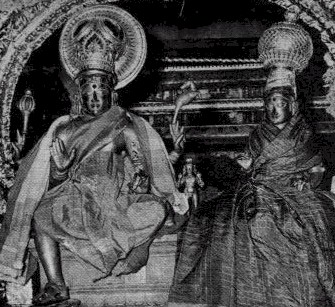
Shiva is referred to as 'the good one' or the 'auspicious one'. Shiva - Rudra is considered to be the destroyer of evil and sorrow. Shiva - Shankara is the doer of good. Shiva is 'tri netra' or three eyed, and is 'neela kantha' - blue necked (having consumed poison to save the world from destruction. Shiva - Nataraja is the Divine Cosmic Dancer. Shiva - Ardhanareeswara is both man and woman.
He is both static and dynamic and is both creator and destroyer. He is the oldest and the youngest, he is the eternal youth as well as the infant. He is the source of fertility in all living beings. He has gentle as well as fierce forms. Shiva is the greatest of renouncers as well as the ideal lover. He destroyes evil and protects good. He bestows prosperity on worshipers although he is austere. He is omnipresent and resides in everyone as pure consciousness.
Shiva is inseparable from Shakti - Parvati the daughter of Himavaan - Haimavati. There is no Shiva without Shakti and no Shakti without Shiva, the two are one - or the absolute state of being - consciousness and bliss.
The five mantras that constitute Shiva's body are Sadyojaata, Vaamadeva, Aghora, Tatpurusha and Eesaana. Eesaana is Shiva not visible to the human eye, Sadyojaata is Shiva realized in his basic reality (as in the element earth, in the sense of smell, in the power of procreation and in the mind). The Vishnudharmottara Purana of the 6th century CE assigns a face and an element to each of the above mantras. (Sadyojaata - earth, Vaamadeva - water, Aghora - fire, Tatpurusha - air and Eesaana - space).
The names of the deified faces with their elements are Mahadeva (earth), Bhairava (fire), Nandi (air), Uma (water) and Sadasiva (space). Panchamukha lingams have been seen from the 2nd century onwards. The Trimurthi Sadasiva image of Shiva in the Elephanta Caves near Mumbai is a portrayal in stone, of the five faces of Shiva. The fourth and the fifth heads are not seen in this image here.
The works of sages Vyasa, Vasishta, Patanjali, the poet Kalidasa, the tamil saint poets Nayanmars - Appar, Sundarar, Sambandar, the poet Manikkavachakar, the mystic tamil siddhas, tantric philosophers, the spiritual leader Adi Sankaracharya and others such as Basavanna and Appayya Deekshitar speak of the attributes of Shiva.
Friday, March 25, 2011
The SHIVA Braille Foundation
The SHIVA Braille Foundation

About the SHIVA Braille Foundation
Catalog of Grade 2 English Braille transcriptions
Children's lessons on Hinduism
One-On-One Companion Book
HINDUISM TODAY, the bi-monthly Hindu family magazine
Loving Ganesha, Hinduism’s Endearing Elephant-Faced God
Dancing with Shiva , Hinduism'sContemporary Catechism
Merging with Shiva, Hinduism’s Contemporary Metaphysics
Living with Shiva, Hinduism's 365 Nandinatha Sutras
Saivite Virtue, Brahmachariya, the Path to Perfection
Weaver's Wisdom, Ancient Precepts for A Perfect Life, Saint Tiruvalluvar's ancient Tirukural
The 2001 Master Course, Himalayan Academy's Lifetime Trilogy with one daily lesson from Dancing with Shiva, Living with Shiva and Merging with Shiva
Current Other Projects
Future Dreams and Projects
Subscribe to:
Posts (Atom)
